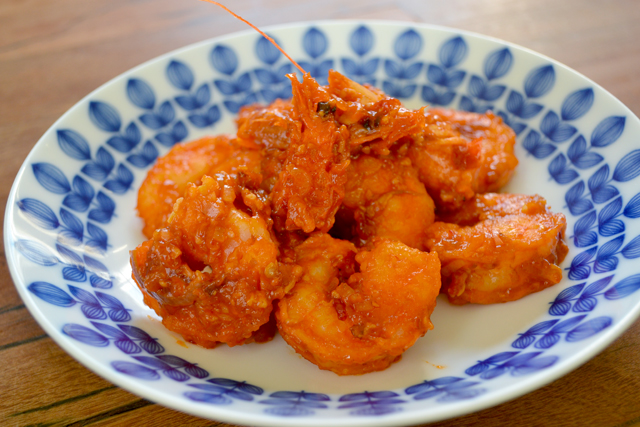
Ebi Chili is the best example of a dish that has been Japanified. It was originally created in the 1950s by a Chinese immigrant in Japan, taking cues from Sichuan-style cooking. It's a shrimp dish that has a little spice and a little sweetness, perfect for the Japanese palate that typically can't handle serious heat.
I remember loving Ebi Chili as a kid. My mom didn't make it, so it was a special treat when we went to a Chinese restaurant in Tokyo and it'd end up in front of me.
The plump shrimp in the bright, red sauce delights me to this day. Shrimp, lightly fried and then drowned in sauce -- how could it not be good?! And I absolutely love how Japanese foods unapologetically use mayonnaise and ketchup as ingredients in recipes -- Ebi Chili is no exception as one of the main ingredients is ketchup.
Kayoko's mom, Hideko-san, gave me the essential Ebi Chili ingredient,
jiuniang. It tastes similar to amazake and provides depth to the Ebi Chili dish. It is made by fermenting glutinous rice with a starter containing yeast and koji (
aspergillus oryzae), which is pretty much how you make
amazake as well.
Making shrimp is a pain in the ass, plain and simple. It totally grosses me out when shrimp in restaurants aren't deveined. You HAVE to devein them, or else you will gross yourself out knowing you are eating tubes of shrimp shit. But there is a reason why, once in a while, I'll set aside enough time to prepare shrimp. And that reason is that it's freaking delicious.
As usual, I always buy my shrimp with heads. All the lovely head juice is so useful when I want to pump up the umami in my miso soup or sauces.
INGREDIENTS
1 lb of shrimp (head on)
1 shallot or 3 stalks of green onions
1 tbsp of ginger
3 close of garlic
Sauce
2 tbsp ketchup
2 tbsp tobanjan (find at any Asian market)
1 tbsp sriracha (if you like spice)
1 tsp honey (or 1/2 tsp sugar)
3 tbsp sake
3 tbsp jiuniang (you can find this at Chinese markets, or make your own
amazake)
METHOD
1. Separate the shrimp heads from the tails. Peel the skins from the tail.
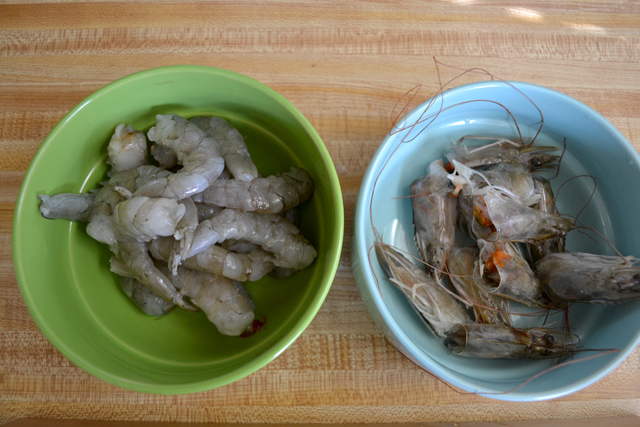
2. Devein the shrimp.
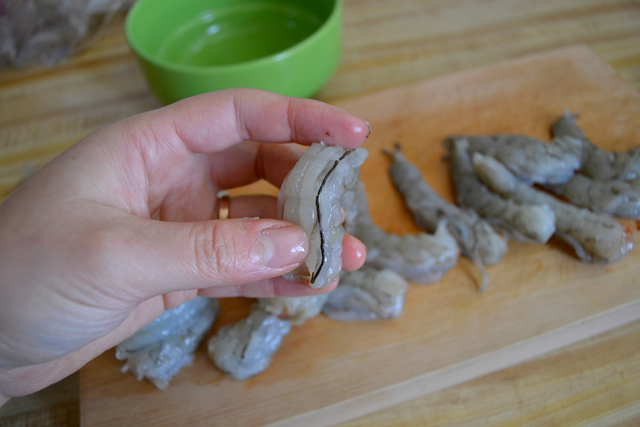
3. Sprinkle with a tablespoon of baking soda. Coating each shrimp with baking soda and then submerging them in ice water ensures a crisp shrimp. In Japanese this texture is referred to as
puri puri (similar to the word "bouncy").
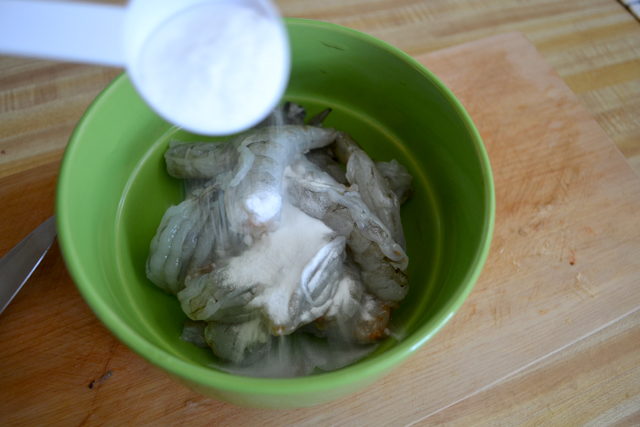
4. Dunk in ice water set aside for 10 minutes.

5. Mince the shallots, garlic and ginger.

6. Once the 10 minutes for the shrimp are up, raise them in a collander and pat dry with paper towels. Then coat them with potato starch.

7. Add about 1/4 inch of oil to a frying pan and fry the shrimp, about 1-2 minutes on each side.
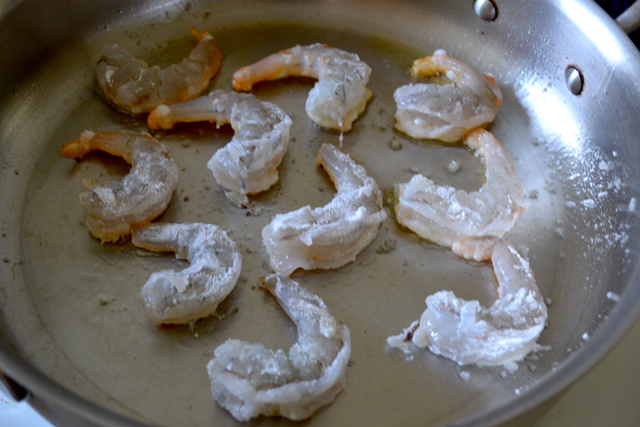
8. This is when you realize it was so worth it to take all that time to devein the shrimp. Set the fried shrimp aside on a paper towel.
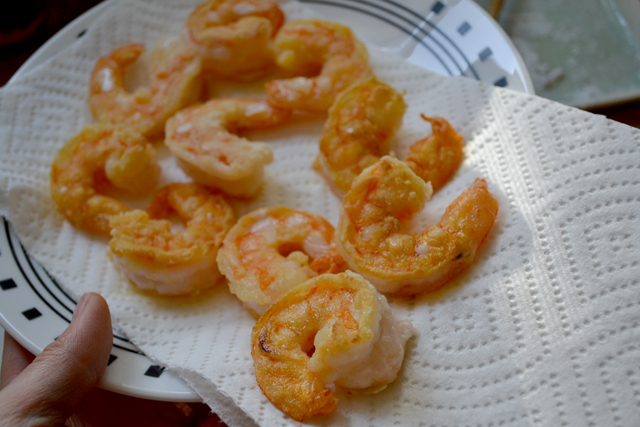
9. Mix the jiuniang, tobanjan, honey, ketchup, sake and sriracha together.
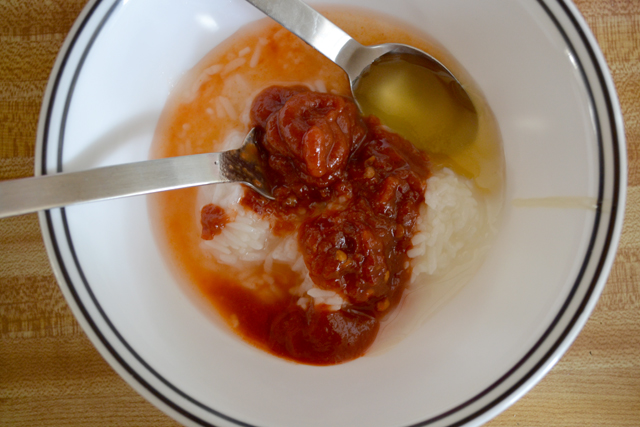
10. In another pot, heat some oil in a pan. Add the ginger, shallots, garlic and shrimp heads and saute on med-hi for about 3 minutes or until you start to smell the aromatics and the shrimp heads start to turn pink. Turn the heat down to medium.
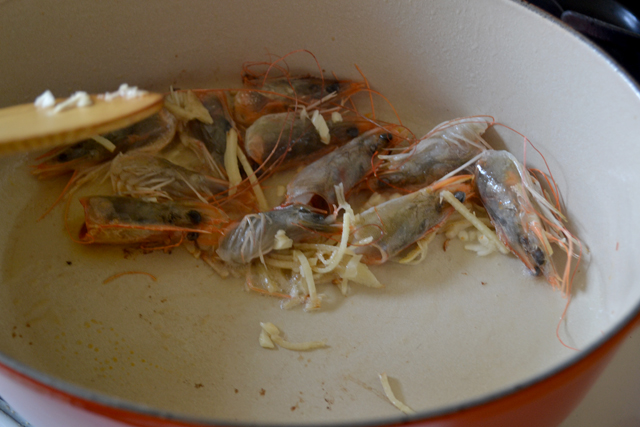
11. Then add the ketchup mixture to the heads.
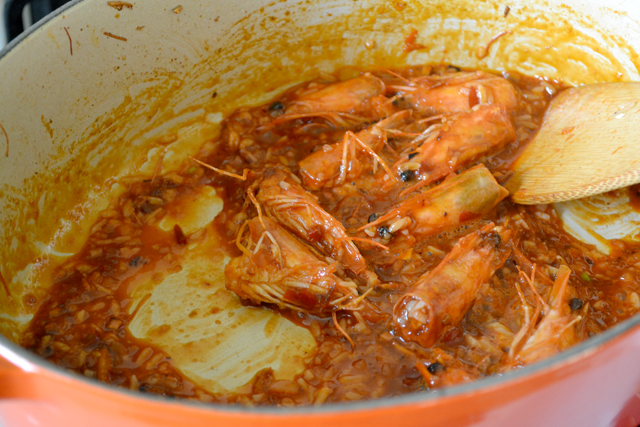
12. Add the fried shrimp and stir well for a couple minutes.
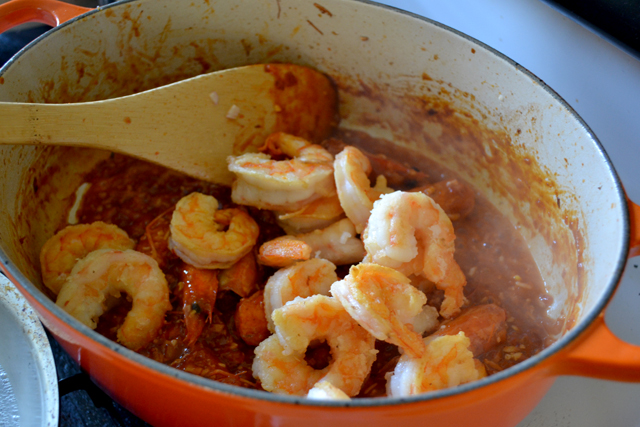
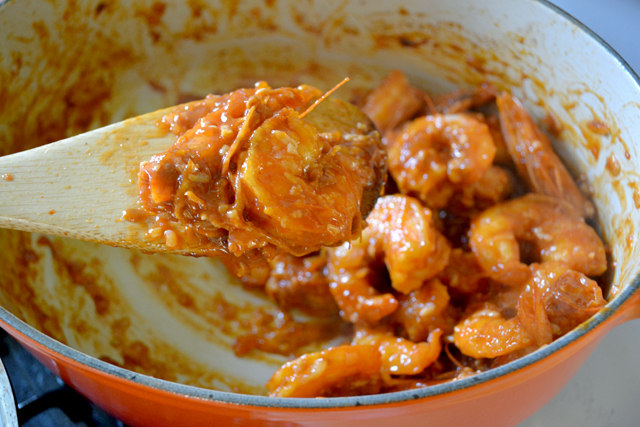
13. Serve hot with fresh white rice.

I've often felt like Japanese culture is a hotbed for reinterpretation and appropriation. Even though new inventions get all the attention, I think reinterpretation is just as important in this post post-modern world. Because, without reinterpretation, Ebi Chili would not exist. And Ebi Chili is just as important as the iPad to me.
 Ebi Chili is the best example of a dish that has been Japanified. It was originally created in the 1950s by a Chinese immigrant in Japan, taking cues from Sichuan-style cooking. It's a shrimp dish that has a little spice and a little sweetness, perfect for the Japanese palate that typically can't handle serious heat.
I remember loving Ebi Chili as a kid. My mom didn't make it, so it was a special treat when we went to a Chinese restaurant in Tokyo and it'd end up in front of me.
The plump shrimp in the bright, red sauce delights me to this day. Shrimp, lightly fried and then drowned in sauce -- how could it not be good?! And I absolutely love how Japanese foods unapologetically use mayonnaise and ketchup as ingredients in recipes -- Ebi Chili is no exception as one of the main ingredients is ketchup.
Kayoko's mom, Hideko-san, gave me the essential Ebi Chili ingredient, jiuniang. It tastes similar to amazake and provides depth to the Ebi Chili dish. It is made by fermenting glutinous rice with a starter containing yeast and koji (aspergillus oryzae), which is pretty much how you make amazake as well.
Making shrimp is a pain in the ass, plain and simple. It totally grosses me out when shrimp in restaurants aren't deveined. You HAVE to devein them, or else you will gross yourself out knowing you are eating tubes of shrimp shit. But there is a reason why, once in a while, I'll set aside enough time to prepare shrimp. And that reason is that it's freaking delicious.
As usual, I always buy my shrimp with heads. All the lovely head juice is so useful when I want to pump up the umami in my miso soup or sauces.
INGREDIENTS
1 lb of shrimp (head on)
1 shallot or 3 stalks of green onions
1 tbsp of ginger
3 close of garlic
Sauce
2 tbsp ketchup
2 tbsp tobanjan (find at any Asian market)
1 tbsp sriracha (if you like spice)
1 tsp honey (or 1/2 tsp sugar)
3 tbsp sake
3 tbsp jiuniang (you can find this at Chinese markets, or make your own amazake)
METHOD
1. Separate the shrimp heads from the tails. Peel the skins from the tail.
Ebi Chili is the best example of a dish that has been Japanified. It was originally created in the 1950s by a Chinese immigrant in Japan, taking cues from Sichuan-style cooking. It's a shrimp dish that has a little spice and a little sweetness, perfect for the Japanese palate that typically can't handle serious heat.
I remember loving Ebi Chili as a kid. My mom didn't make it, so it was a special treat when we went to a Chinese restaurant in Tokyo and it'd end up in front of me.
The plump shrimp in the bright, red sauce delights me to this day. Shrimp, lightly fried and then drowned in sauce -- how could it not be good?! And I absolutely love how Japanese foods unapologetically use mayonnaise and ketchup as ingredients in recipes -- Ebi Chili is no exception as one of the main ingredients is ketchup.
Kayoko's mom, Hideko-san, gave me the essential Ebi Chili ingredient, jiuniang. It tastes similar to amazake and provides depth to the Ebi Chili dish. It is made by fermenting glutinous rice with a starter containing yeast and koji (aspergillus oryzae), which is pretty much how you make amazake as well.
Making shrimp is a pain in the ass, plain and simple. It totally grosses me out when shrimp in restaurants aren't deveined. You HAVE to devein them, or else you will gross yourself out knowing you are eating tubes of shrimp shit. But there is a reason why, once in a while, I'll set aside enough time to prepare shrimp. And that reason is that it's freaking delicious.
As usual, I always buy my shrimp with heads. All the lovely head juice is so useful when I want to pump up the umami in my miso soup or sauces.
INGREDIENTS
1 lb of shrimp (head on)
1 shallot or 3 stalks of green onions
1 tbsp of ginger
3 close of garlic
Sauce
2 tbsp ketchup
2 tbsp tobanjan (find at any Asian market)
1 tbsp sriracha (if you like spice)
1 tsp honey (or 1/2 tsp sugar)
3 tbsp sake
3 tbsp jiuniang (you can find this at Chinese markets, or make your own amazake)
METHOD
1. Separate the shrimp heads from the tails. Peel the skins from the tail.
 2. Devein the shrimp.
2. Devein the shrimp.
 3. Sprinkle with a tablespoon of baking soda. Coating each shrimp with baking soda and then submerging them in ice water ensures a crisp shrimp. In Japanese this texture is referred to as puri puri (similar to the word "bouncy").
3. Sprinkle with a tablespoon of baking soda. Coating each shrimp with baking soda and then submerging them in ice water ensures a crisp shrimp. In Japanese this texture is referred to as puri puri (similar to the word "bouncy").
 4. Dunk in ice water set aside for 10 minutes.
4. Dunk in ice water set aside for 10 minutes.
 5. Mince the shallots, garlic and ginger.
5. Mince the shallots, garlic and ginger.
 6. Once the 10 minutes for the shrimp are up, raise them in a collander and pat dry with paper towels. Then coat them with potato starch.
6. Once the 10 minutes for the shrimp are up, raise them in a collander and pat dry with paper towels. Then coat them with potato starch.
 7. Add about 1/4 inch of oil to a frying pan and fry the shrimp, about 1-2 minutes on each side.
7. Add about 1/4 inch of oil to a frying pan and fry the shrimp, about 1-2 minutes on each side.
 8. This is when you realize it was so worth it to take all that time to devein the shrimp. Set the fried shrimp aside on a paper towel.
8. This is when you realize it was so worth it to take all that time to devein the shrimp. Set the fried shrimp aside on a paper towel.
 9. Mix the jiuniang, tobanjan, honey, ketchup, sake and sriracha together.
9. Mix the jiuniang, tobanjan, honey, ketchup, sake and sriracha together.
 10. In another pot, heat some oil in a pan. Add the ginger, shallots, garlic and shrimp heads and saute on med-hi for about 3 minutes or until you start to smell the aromatics and the shrimp heads start to turn pink. Turn the heat down to medium.
10. In another pot, heat some oil in a pan. Add the ginger, shallots, garlic and shrimp heads and saute on med-hi for about 3 minutes or until you start to smell the aromatics and the shrimp heads start to turn pink. Turn the heat down to medium.
 11. Then add the ketchup mixture to the heads.
11. Then add the ketchup mixture to the heads.
 12. Add the fried shrimp and stir well for a couple minutes.
12. Add the fried shrimp and stir well for a couple minutes.

 13. Serve hot with fresh white rice.
13. Serve hot with fresh white rice.
 I've often felt like Japanese culture is a hotbed for reinterpretation and appropriation. Even though new inventions get all the attention, I think reinterpretation is just as important in this post post-modern world. Because, without reinterpretation, Ebi Chili would not exist. And Ebi Chili is just as important as the iPad to me.
I've often felt like Japanese culture is a hotbed for reinterpretation and appropriation. Even though new inventions get all the attention, I think reinterpretation is just as important in this post post-modern world. Because, without reinterpretation, Ebi Chili would not exist. And Ebi Chili is just as important as the iPad to me.




Comments (3)
I’m making this asap!!! Do you get your shrimp at Monterey Fish? They’re gorgeous!
This looks so yum! And yes, I too have always found amusing the deep, unapologetic love that the Japanese have for mayo & ketchup!
Hey Kayoko, I get my shrimp at Tokyo Fish Market because they always have them with the heads on. Most asian grocers should sell them heads-on.
Chungy – Mayo and ketchup forever!!!